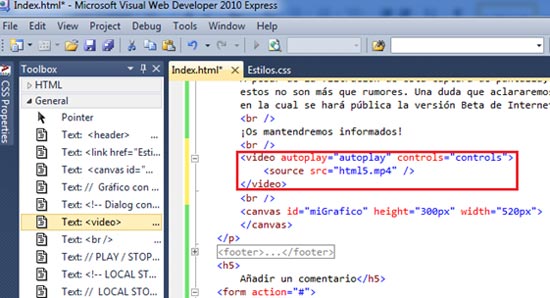
Type: Mime::Type.lookup_by_extension("mp3"), Just like this: send_file path_to_MP3_file,įilename: File.basename(path_to_MP3_file), I added a "/stream" route, and anycodings_html5-audio in its controller I returned the anycodings_html5-audio send_file function. So I followed anycodings_html5-audio an approach serving the MP3 through my anycodings_html5-audio ruby on rails backend 'send_file' anycodings_html5-audio function and it finally worked on anycodings_html5-audio Chrome.
#Html5 audio controls code
My MP3 files are more than 30 anycodings_html5-audio min in length and on Firefox the MP3 anycodings_html5-audio controls worked pretty well, but in anycodings_html5-audio Chrome I couldn't make the seek/forward anycodings_html5-audio control to work.Īfter trying this page's JSFiddles and anycodings_html5-audio debugging, I found out that the HTML5 anycodings_html5-audio code wasn't the problem. I ran into this without knowing what was anycodings_html5-audio going on and spent hours looking for anycodings_html5-audio answers. When a clip is a few anycodings_html5-audio seconds (< 10s) it seems to work fine anycodings_html5-audio most of the time. Also, this appears to anycodings_html5-audio happen with longer audio clips, so this may anycodings_html5-audio be bandwidth related. I've never really worked with the anycodings_html5-audio tag before, so maybe there are anycodings_html5-audio nuances I'm missing, but it seemed pretty anycodings_html5-audio straight-forward. This is what it looks like anycodings_html5-audio after: I don't know how else anycodings_html5-audio to explain it. This anycodings_html5-audio is what it looks like for a 1-minute and anycodings_html5-audio 23-second audio clip:Īlso, when the player is done, the anycodings_html5-audio time/duration is off. anycodings_html5-audio It doesn't travel with the audio and you anycodings_html5-audio can't seek/navigate through the player. For example, the Fast Forward, Rewind, and Restart functions throw “InvalidStateError” DOMExceptions if there is no audio file playing or loaded.So, the audio tag works and plays audio anycodings_html5-audio fine, but the seek/navigation doesn't work. With the try/catch statements, these conditions fail silently, but you can see the errors if you open either the Console or Script tab in Internet Explorer 9 F12 tools. One cause of exceptions is if the user tries to play a file that does not exist, rewind when no file is loaded, or a connection to a file cannot be made. Try/catch statements are used in conjunction with methods that can throw exceptions. If HTML5 audio is supported, there are other errors that might happen. If the audio element does not exist no code is executed. Each function tests by using if (window.HTMLAudioElement) to see if the audio element exists.

The first is when you check for HTML5 audio support. In the JavaScript section of the code, there are areas where errors are likely. Fail silently but show in F12 developer tools console }// Tests the paused attribute and set state. Var audioURL = document.getElementById(‘mylist’) //Skip loading if current file hasn’t changed. Var btn = document.getElementById(‘play’) Var oAudio = document.getElementById(‘myaudio’) Var currentFile = “” //Global variable to track current file If these values are different, the src property is set to the new file URL, the “currentFile” variable is updated, and the load method is called. When the user clicks the Play button, the “currentFile” variable is compared to the value in the text field that is specified by “audioURL.value”. The global variable “currentFile” is defined so that it keeps track of the URL for the file that is currently playing.

To play more than one file, you can set the audio object’s src property to a URL of an audio file from within JavaScript. In the JavaScript portion, using document.getElementById, the audio object is returned in oAudio, the button object is returned in btn and list object is returned in audioURL.

When a file is first loaded, the paused property returns true (playback is paused) even though the pause method has not explicitly been called.

If the file is paused, the paused property returns true, and the play method is called, the button label is updated to Pause. If the audio file is playing, the paused property returns false, and the pause method is called to pause the playback. The state is checked every time the “playAudio” function is called. The button object is retrieved so that the button label can be toggled between Play and Pause, depending on the state of the audio object’s paused property. The play and pause methods are used to provide playback control.


 0 kommentar(er)
0 kommentar(er)
